| |
Home
Famous and Fascinating Women in History
Frontiersmen and Women
The World's Greatest Composers
Famous Women Spies
Great Authors of the World
Generals and other Noteworthy People
from the Civil War
The Presidents of the United States
The First Ladies of the United States
Homes and Monuments of and to
Famous People
Historical People and Events by Month for Each Day of the Year!
Famous Figures in Black History
The Calvert Family and the Lords Baltimore
Understanding the American Revolution and its People
Everything Beatles!
Everything Maryland! |
| |
|
 
|
 |  |
Stephen Grover Cleveland, His life, Presidency, and Birthplace
By
John T. Marck
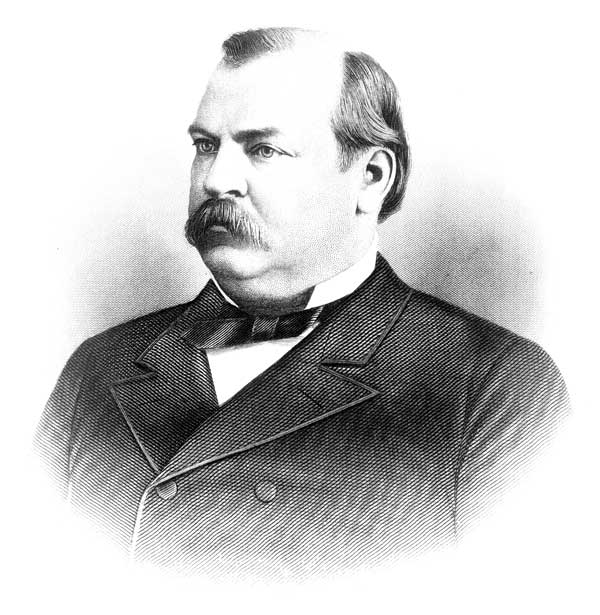
The man who
would become the 22nd and 24th President of the
United States, and in doing so became the only President to serve two
non-consecutive terms, was born Stephen Grover Cleveland on March 18,
1837 in the Manse, which was the official residence of the First
Presbyterian Church, where his father was pastor from 1834 to 1841.
This home in Caldwell, New Jersey was here his father, Richard Falley
Cleveland, originally from Connecticut, and his mother, Ann Neal, from
Baltimore, lived while Richard was the church pastor.
Stephen Grover
was the fifth of nine children born to Richard and Ann, who had four
other sons and four daughters. He was named Stephen Grover in
honor of the first pastor of the First Presbyterian Church of
Caldwell, where his father was pastor. Although named Stephen,
he never used this name in his adult life, preferring Grover.
In 1841, the
Cleveland family moved to Fayetteville, New York where Grover spent
much of his childhood. In 1850, Cleveland’s father took a job in
Clinton, New York and the family relocated here. They moved again in
1853 to Holland Patent, New York, which is near Utica. Soon after
arriving here, Richard Cleveland, Grover’s father, died.
Early Education
Grover
Cleveland’s education began in Fayetteville, New York at the
Fayetteville Academy, a grammar school. When his family moved to
Clinton, he attended the Clinton Liberal Academy. Following his
father’s death in 1853, Grover left school and worked to help support
his family. Later in the year, 1853, Grover’s brother William
was hired as a teacher at the New York Institute for the Blind in New
York City, and he obtained a place for Grover as an assistant teacher.
After teaching for one year, Grover returned home to Holland Patent at
years end, 1854.
Back at
Holland Patent, Grover, now 17 years old, looked for work, but was not
successful. An elder in the church there offered to help Grover by
paying for his college education if he would promise to become a
minister, but Grover declined. Instead, he decided to move west
to the city of Cleveland, Ohio. First; however, he stopped in
Buffalo, where his uncle lived. His uncle, Lewis W. Allen,
dissuaded him from continuing west, by offering him a job arranging
his herd books. A Herd book is a book containing the list of pedigrees
of one or more herds of choice breeds of cattle, also referred to as a
herd record or herd register.
Grover’s uncle
Lewis was an important man in Buffalo and he introduced Grover to many
influential men there, including partners in the law firm of Rogers,
Bowen, and Rogers. It was here that Grover took a clerkship job and
was admitted to the bar in 1859. Once a lawyer, Cleveland worked with
this firm for three years, leaving in 1862 to start his own practice.
In January 1863, he accepted an appointment as an assistant district
attorney for Erie County. With the Civil War rampant, Congress
passed the Conscription Act of 1863 (draft) that required able-bodied
men to serve in the army if called upon, or else hire a replacement.
Cleveland choose the latter and paid George Benninsky $150 to serve in
his place.
As an
attorney, Cleveland became known for his tireless hard work, He also
assisted others by defending people free of charge. During this time,
Cleveland lived a simple life in a boarding house, although by this
time he could afford more lavish housing. He continued to
support his mother and sisters, while at the same time, enjoyed an
active social life, frequenting hotel lobbies and saloons.
Democratic Party and Sheriff
of Erie County
When Cleveland first began his
involvement with politics and politicians he aligned himself with the
Democratic Party. In 1865 he ran for District Attorney, losing
narrowly to his friend and Roommate, Lyman K. Bass, a Republican.
Cleveland stayed out of politics for the next few years, but decided
in 1870 to run for sheriff. With the help of a friend, he secured the
Democratic nomination for sheriff, and was elected at the age of 33,
by a 303-vote margin, taking office on January 1, 1871. While
this new career took him away from practicing law, it was rewarding in
other ways, one being the fees were said to yield up to $40,000 over
his two-year term.
As sheriff, the
most well known incident was when Cleveland was responsible for
carrying out an execution or paying a deputy $10 to perform the
hanging. Although not delighted with this responsibility, Cleveland
opted to carry out the duty. He did this two times, the first
was the hanging of Patrick Morrisey, a convicted murdered, on
September 6, 1872, and another murdered, John Gaffney on February 14,
1873.
Upon his term of
sheriff ending, Cleveland returned to private practice, opening a law
firm with Lyman K. Bass and Wilson S. Bissell. Bass did not stay
long, having been elected to Congress in 1873, but Cleveland and
Bissell found themselves at the top of Buffalo’s legal community.
Cleveland as Mayor of Buffalo
By the 1870s,
the city of Buffalo had become very corrupt, with both Democrats and
Republicans equally responsible. In 1881, the Republicans nominated a
slate of many disreputable politicians, giving rise to the Democrats
for the opportunity to put their own man in, by gaining votes for a
person who was a more honest candidate. The party leaders
approached Cleveland and he agreed to run for mayor, provided he liked
the remainder of the ticket. When the more “notorious”
politicians were left off the ticket, Cleveland accepted the
nomination. Cleveland won by about 4,000 votes and took office on
January 2, 1882. In his tenure as mayor, Cleveland became known
for having an honest reputation, and this spread beyond just Erie
County.
Governor of New York
As this honest
reputation grew, the state Democrats considered Cleveland for the
office of governor. Throughout many possible candidate and back and
forth decisions, Cleveland became the nominee and won the election,
defeating the Republican nominee Charles J. Folger, 535,318 to
342,464.
Nomination for President
The upcoming
election of 1884 the Democrats saw as their opportunity to take back
the White House from the Republicans, which was in their party since
1856. There were several front-runners including Cleveland, but
most others had some issues. Finally on the second ballot,
Cleveland won the nomination. In the election, the popular vote
was close, with Cleveland winning the electoral majority 219 – 182.

First Term as President
(1885-1889)
One of the
first duties of President is the task of filling all the government
jobs over which he has the power of appointment. Normally the jobs
were filled under the spoils system, but Cleveland decided that he
would not fire any Republican who was doing his job well, or would he
appoint anyone simply because he was a Democrat. In doing his
appointments, Cleveland also reduced the number of federal employees
as many departments had become overstaffed with political
time-servers. Over his term, Cleveland did; however, replace
some partisan Republicans with Democrats. While some of these
decisions were influences by party concerns, most of his appointments
were decided on merit alone.
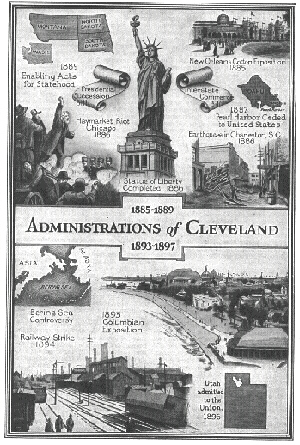
One of the
more volatile issues facing Cleveland and the country in the 1880s was
whether currency should be backed by gold and silver or gold alone.
The issue cut across party lines with western Republicans and southern
Democrats joining together in the call for free coinage of silver, and
both parties holding firm for the gold standard. Because silver was
worth less than its equivalent in gold, taxpayers paid their
government bills in silver, while international creditors demanded
payment in gold, resulting in the depletion of the country’s gold
supply.
President
Cleveland and his Treasury Secretary, Daniel manning, stood firmly on
the side of the gold standard, and tried to reduce the amount of
silver that the government was required to coin under the
Bland-Allison Act of 1878. This angered the westerners and
southerners, who wanted cheap money to help out their poorer
constituents. In reply, a silverite named Richard P. Bland
introduced a bill in 1886 that would require the government to coin
unlimited amounts of silver, inflating the then-deflating currency.
While this bill was defeated, so was a bill the administration favored
that would repeal any silver coinage requirement. The result was
retention of the status quo, and postponed the resolution of the free
silver issue.
White House Wedding
When Grover
Cleveland became President of the United States, he did so as a
bachelor, but did not stay this way for long. In 1885, the daughter of
one of his friend’s, Oscar Folsom, visited him in Washington, D.C.
Frances Folsom was a student at Wells College, and upon her return to
school, Grover obtained permission to correspond with her, and soon
thereafter they became engaged.

On June 2,
1886, Grover Cleveland married Frances in the Blue Room of the White
House. While he was the second President to marry while in
office, he was the first, and continues to be the only President to be
married in the White House. This marriage was unusual because
Cleveland was the executor of Oscar Folsom’s estate and had supervised
Frances’ upbringing, but the public did not take exception to their
wedding. At only 21 years old, Frances was the youngest
First Lady in American history, but within a short time, the public
warmed to her beauty and personality. The Cleveland’s would go
on to have five children. They are: Ruth (1891-1904); Esther
(1893-1980); Marion (1895-1977); Richard Folsom (1897-1974); and
Francis Grover (1903-1995).
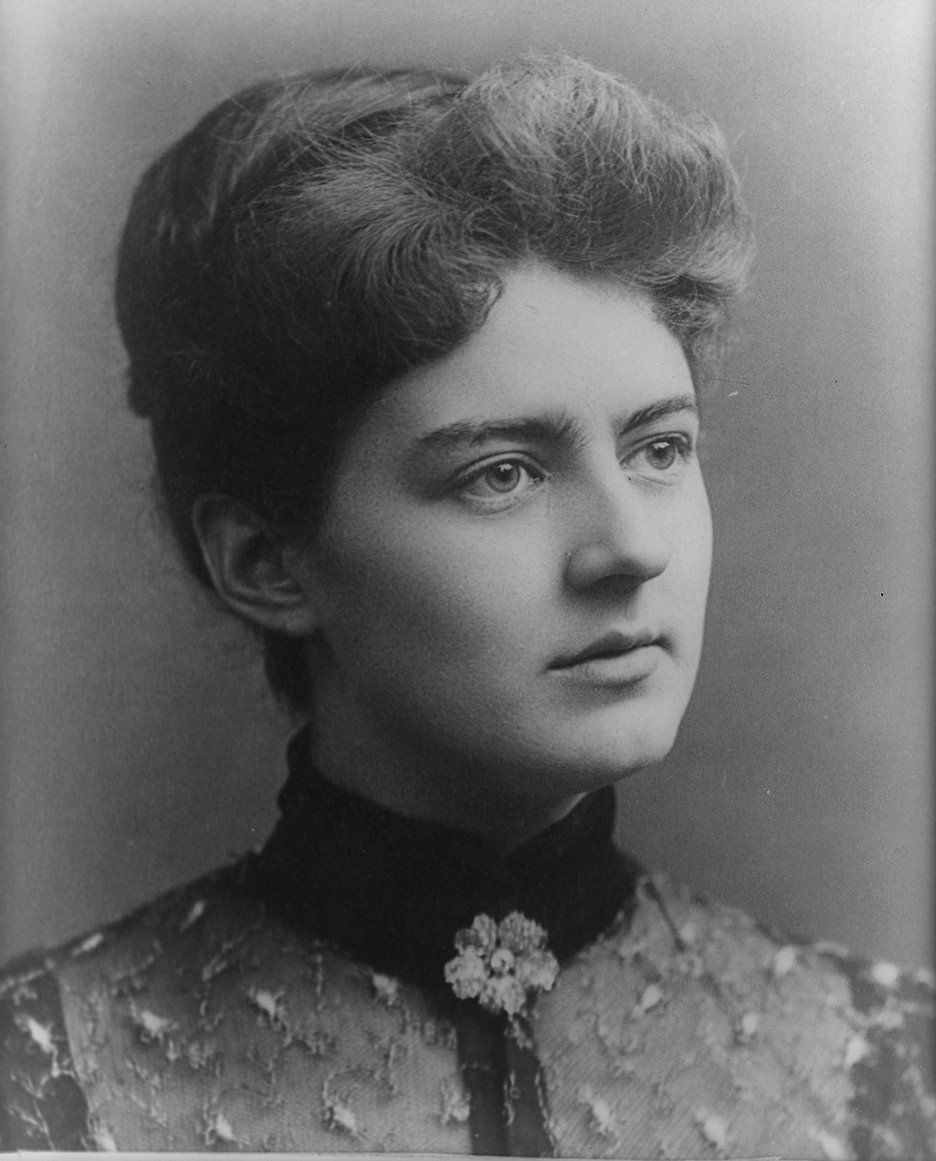
As his first
term came closer to its end, Cleveland did run again. However, as it
did in 1884, the election came down to the swing states of New York,
New Jersey, Connecticut and Indiana. Unlike in 1884 when Cleveland won
all four sates, he now won only two, losing his home state by nearly
15,000 votes. Also the Republicans were victorious in Indiana,
largely because of fraud. This victory where Cleveland lost by only
2,348 votes was enough to cost him the election. In doing so,
Benjamin Harrison was elected President of the United States.
Upon leaving
the White House, Frances is quoted as saying to a staff member, “Now,
Jerry, I want you to take good care of al the furniture and ornaments
in the house, for I want to find everything just as it is now, when we
come back again. “ When asked when she would be returning, she said,
“We are coming back four years from today.”
Meanwhile, the
Cleveland’s moved back to New York City where Grover took a position
with a law firm. While here in New York, their first child, Ruth was
born. During Harrison’s term as President, his
administration worked with Congress to pass the McKinley Tariff and
the Sherman Silver Purchase Act, both of which Cleveland viewed as
dangerous to the nation’s financial health. Initially Cleveland
refrained from criticizing his successor, but by 1891-he felt
compelled to speak out but addressing his concerns in an open letter
to reformers in New York. Known as the “silver letter,” this
thrust Cleveland’s name back into the spotlight as the 1892 election
was nearing.
The Election of 1892
With
his recent out spoken letter on the monetary issues made Cleveland a
major contender for the Democratic nomination for the presidency.
Although his leading opponent was David B. Hill, a senator from New
York, Cleveland was nominated on the first ballot. The
Republicans of course re-nominated Benjamin Harrison making the 1892
election a rematch of the one four years earlier. As the
issues of the day such as tariff reform and the Tammany Hall Democrats
adhered to a national ticket, this allowed united Democrats to carry
New York, and in doing so, Cleveland was elected by a wide margin in
both popular and electoral votes.
Second Term as President
(1893-1897)
In his second
term as President, Cleveland repealed the Sherman Silver Purchase Act,
putting the nation back on the gold standard. He also facilitated the
resolution between Great Britain and Venezuela and between Spain and
Cuba, and by doing so, averted conflict and protected American
interests. He also deployed the US military during the Pullman Palace
Car employment strike in 1894. This maintains civil order and
ensured continued rail transportation of goods and services that
included the US Mail.
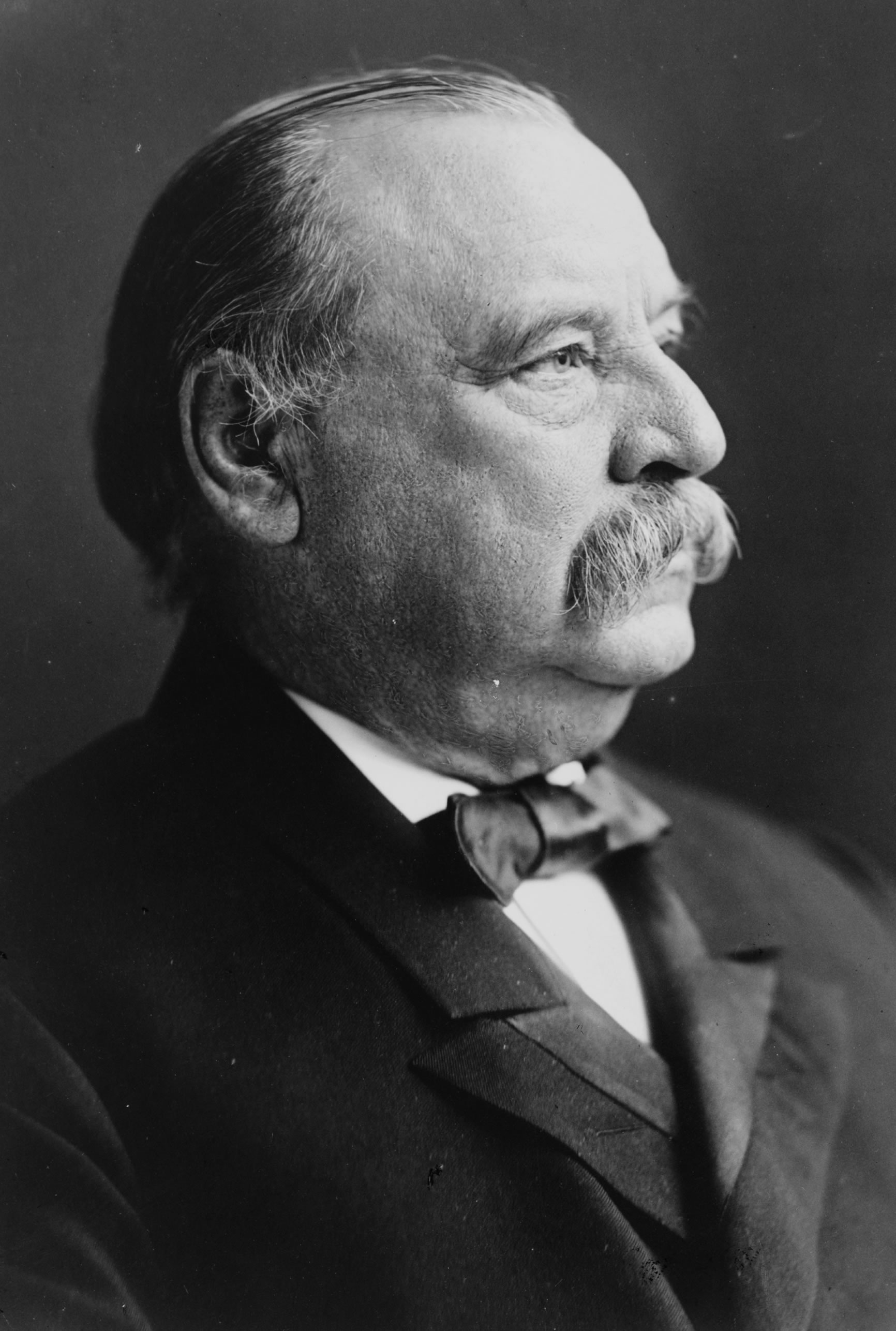
Being quite
forthright in his actions created enemies in both political parties
and among the special interest people. Still, Cleveland was undaunted.
He remained steadfast and resilient in his approach to life that would
go on to define him as a man and a president.
Life after the Presidency
At the end of
his presidency, Cleveland retired to Princeton, New Jersey. Here
he serves as a trustee of Princeton University from 1901 to 1908, and
worked to reform the country’s insurance industry.

Westland Mansion -The Cleveland home in Princeton
Grover
Cleveland’s health had been declining for several years and in the
fall of 1907, he fell seriously ill. On June 24, 1908 he
suffered a heart attack and died. He is buried in the Princeton
Cemetery, and his wife, their daughter Ruth, and his wife’s parents
are buried alongside him.
The
Grover Cleveland Birthplace
T he Grover Cleveland birthplace
is located at 207 Bloomfield Avenue, Caldwell, New Jersey. It is
opened from Wednesday to Sunday, and visitors are asked to call for
operating hours. Admission to the house is free.
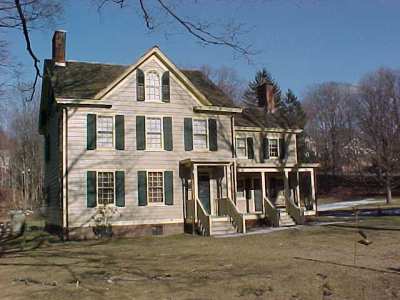
This house,
called a Manse, meaning the pastor’s house, for the First Presbyterian
Church, was the residence of the Cleveland family for a time and
Grover’s birthplace.
Originally the
house had a two-story main section with a one-story kitchen to the
east and a one-story lean-to at the rear. It was enlarged several
times between 1848 and 1870 to meet the growing needs of the
Presbyterian clergy. The historical significance of the Manse was
first noted in 1881 when Cleveland was running for governor of New
York. As his political career and popularity increased, so did
interest in preserving his birthplace as museum. Therefore, a group of
friends and admirers began plans to purchase the Manse in 1907.
Through their efforts, the house opened to the public on March 18,
1913.
Much of the
first floor of the Manse portray the house as it was in 1837, the year
Grover was born. The middle-class character of the house reflects the
day-to-day life of the Cleveland family. Among the artifacts here are
Grover’s cradle, his White House chair, and original family portraits.
The Grover Cleveland Birthplace State Historic Site is the only
museum in the United States dedicated to the interpretation of
President Cleveland’s life. It is also the nations’ leading repository
of his artifacts and political memorabilia. This site is listed on the
New Jersey and National Registers of Historic Places.
Quick Biographical Facts
GROVER CLEVELAND
22nd and 24th President
Term- March 5, 1885 to March 4, 1889
Term- March 4, 1893 to March 4, 1897
Republican Party
Birth: Caldwell, New Jersey, March 18, 1837.
Ancestry: Irish-English
Marriage: Washington, D.C., June 2, 1886 (The White
House) to Frances Folsom who was born in Buffalo, New York, July 21,
1864. Frances died in Baltimore, Maryland, October 29, 1947, and is
buried in Princeton Cemetery, Princeton, New Jersey.
Children: Ruth (1891-1904); Esther (1893-1980);
Marion (1895-1977); Richard Folsom (1897-1974); Francis Grover (1903-
).
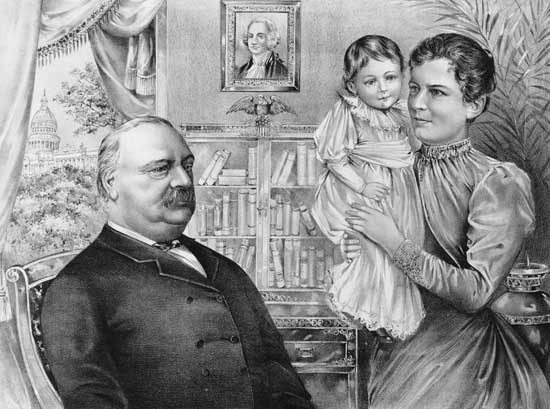
Home: "Westland", Princeton, New Jersey.
Education: Public schools
Religion: Presbyterian
Occupation before Presidency: Lawyer
Pre-Presidential Offices: Erie County Assistant
District Attorney; Sheriff of Erie County; Mayor of Buffalo; Governor
of New York.
Age at Inauguration: 47
First Administration: Vice President: Thomas A.
Hendricks of Indiana, Inauguration March 4, 1885, The Capital,
Washington, D.C.
Second Administration: Vice President: Adlai E.
Stevenson of Illinois, Inauguration March 4, 1893, The Capital,
Washington, D.C.
Occupation after Presidency: Princeton University
Trustee.
Death: Princeton, New Jersey, June 24, 1908.
Cause of Death: Heart Attack at age 71.
Place of Burial: Princeton Cemetery, Princeton, New
Jersey.
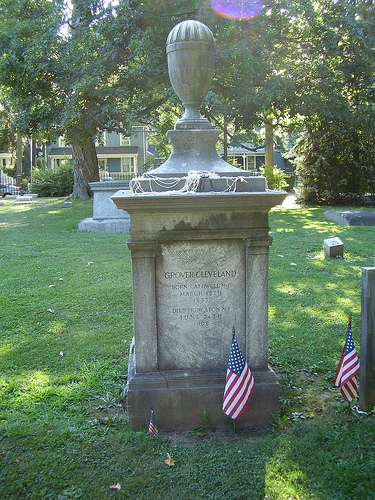
Interesting Facts:
Cleveland was the only President to serve two
terms that did not follow each other.
Cleveland was the only President to be married
in the White House, and his daughter Esther, was the only
President's child born there.
He used his presidential veto to override the
wishes of Congress over 300 times, more than twice as often as all
the earlier President's combined.

Copyright © 1992-2022 John T. Marck.
Written and edited by John T. Marck. Grateful appreciation for their
informational assistance is extended to: The Grover Cleveland
Birthplace State Historic Site; Wikipedia, relative to Grover
Cleveland and his life; The Cleveland Birthplace.org; The New Jersey
State Historic Sites, NJ Department of Environmental Protection,
Division of parks and Forestry, and the State Park Service; Planet
Ware, relative to Grover Cleveland and Caldwell, New Jersey Tourism;
History on the Spot, relative to the Grover Cleveland Birthplace State
Historic Site; Infoplease, relative to Grover Cleveland; The
Presidents of the United States, by John T. Marck, and The First
ladies of the United States, by John T. Marck, © 1993-2008.
A
Splendid Time Is Guaranteed For All
| | |
| |
|

